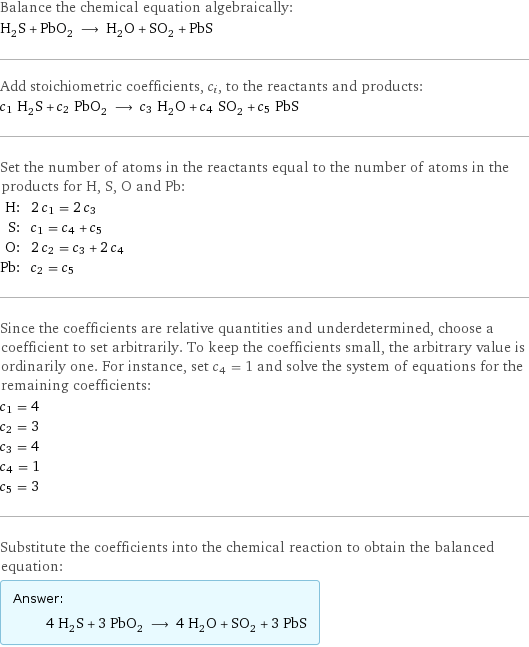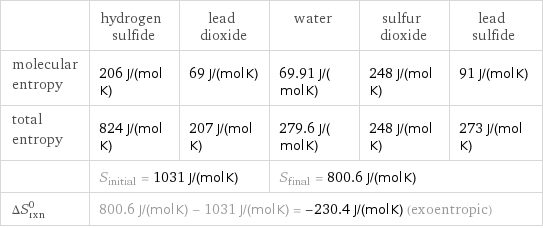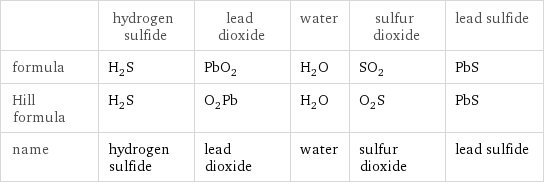Input interpretation

H_2S hydrogen sulfide + PbO_2 lead dioxide ⟶ H_2O water + SO_2 sulfur dioxide + PbS lead sulfide
Balanced equation

Balance the chemical equation algebraically: H_2S + PbO_2 ⟶ H_2O + SO_2 + PbS Add stoichiometric coefficients, c_i, to the reactants and products: c_1 H_2S + c_2 PbO_2 ⟶ c_3 H_2O + c_4 SO_2 + c_5 PbS Set the number of atoms in the reactants equal to the number of atoms in the products for H, S, O and Pb: H: | 2 c_1 = 2 c_3 S: | c_1 = c_4 + c_5 O: | 2 c_2 = c_3 + 2 c_4 Pb: | c_2 = c_5 Since the coefficients are relative quantities and underdetermined, choose a coefficient to set arbitrarily. To keep the coefficients small, the arbitrary value is ordinarily one. For instance, set c_4 = 1 and solve the system of equations for the remaining coefficients: c_1 = 4 c_2 = 3 c_3 = 4 c_4 = 1 c_5 = 3 Substitute the coefficients into the chemical reaction to obtain the balanced equation: Answer: | | 4 H_2S + 3 PbO_2 ⟶ 4 H_2O + SO_2 + 3 PbS
Structures

+ ⟶ + +
Names

hydrogen sulfide + lead dioxide ⟶ water + sulfur dioxide + lead sulfide
Reaction thermodynamics
Enthalpy

| hydrogen sulfide | lead dioxide | water | sulfur dioxide | lead sulfide molecular enthalpy | -20.6 kJ/mol | -277.4 kJ/mol | -285.8 kJ/mol | -296.8 kJ/mol | -100.4 kJ/mol total enthalpy | -82.4 kJ/mol | -832.2 kJ/mol | -1143 kJ/mol | -296.8 kJ/mol | -301.2 kJ/mol | H_initial = -914.6 kJ/mol | | H_final = -1741 kJ/mol | | ΔH_rxn^0 | -1741 kJ/mol - -914.6 kJ/mol = -826.7 kJ/mol (exothermic) | | | |
Gibbs free energy

| hydrogen sulfide | lead dioxide | water | sulfur dioxide | lead sulfide molecular free energy | -33.4 kJ/mol | -217.3 kJ/mol | -237.1 kJ/mol | -300.1 kJ/mol | -98.7 kJ/mol total free energy | -133.6 kJ/mol | -651.9 kJ/mol | -948.4 kJ/mol | -300.1 kJ/mol | -296.1 kJ/mol | G_initial = -785.5 kJ/mol | | G_final = -1545 kJ/mol | | ΔG_rxn^0 | -1545 kJ/mol - -785.5 kJ/mol = -759.1 kJ/mol (exergonic) | | | |
Entropy

| hydrogen sulfide | lead dioxide | water | sulfur dioxide | lead sulfide molecular entropy | 206 J/(mol K) | 69 J/(mol K) | 69.91 J/(mol K) | 248 J/(mol K) | 91 J/(mol K) total entropy | 824 J/(mol K) | 207 J/(mol K) | 279.6 J/(mol K) | 248 J/(mol K) | 273 J/(mol K) | S_initial = 1031 J/(mol K) | | S_final = 800.6 J/(mol K) | | ΔS_rxn^0 | 800.6 J/(mol K) - 1031 J/(mol K) = -230.4 J/(mol K) (exoentropic) | | | |
Equilibrium constant
![Construct the equilibrium constant, K, expression for: H_2S + PbO_2 ⟶ H_2O + SO_2 + PbS Plan: • Balance the chemical equation. • Determine the stoichiometric numbers. • Assemble the activity expression for each chemical species. • Use the activity expressions to build the equilibrium constant expression. Write the balanced chemical equation: 4 H_2S + 3 PbO_2 ⟶ 4 H_2O + SO_2 + 3 PbS Assign stoichiometric numbers, ν_i, using the stoichiometric coefficients, c_i, from the balanced chemical equation in the following manner: ν_i = -c_i for reactants and ν_i = c_i for products: chemical species | c_i | ν_i H_2S | 4 | -4 PbO_2 | 3 | -3 H_2O | 4 | 4 SO_2 | 1 | 1 PbS | 3 | 3 Assemble the activity expressions accounting for the state of matter and ν_i: chemical species | c_i | ν_i | activity expression H_2S | 4 | -4 | ([H2S])^(-4) PbO_2 | 3 | -3 | ([PbO2])^(-3) H_2O | 4 | 4 | ([H2O])^4 SO_2 | 1 | 1 | [SO2] PbS | 3 | 3 | ([PbS])^3 The equilibrium constant symbol in the concentration basis is: K_c Mulitply the activity expressions to arrive at the K_c expression: Answer: | | K_c = ([H2S])^(-4) ([PbO2])^(-3) ([H2O])^4 [SO2] ([PbS])^3 = (([H2O])^4 [SO2] ([PbS])^3)/(([H2S])^4 ([PbO2])^3)](../image_source/3d373d964878a7d2e97e80de850ddf09.png)
Construct the equilibrium constant, K, expression for: H_2S + PbO_2 ⟶ H_2O + SO_2 + PbS Plan: • Balance the chemical equation. • Determine the stoichiometric numbers. • Assemble the activity expression for each chemical species. • Use the activity expressions to build the equilibrium constant expression. Write the balanced chemical equation: 4 H_2S + 3 PbO_2 ⟶ 4 H_2O + SO_2 + 3 PbS Assign stoichiometric numbers, ν_i, using the stoichiometric coefficients, c_i, from the balanced chemical equation in the following manner: ν_i = -c_i for reactants and ν_i = c_i for products: chemical species | c_i | ν_i H_2S | 4 | -4 PbO_2 | 3 | -3 H_2O | 4 | 4 SO_2 | 1 | 1 PbS | 3 | 3 Assemble the activity expressions accounting for the state of matter and ν_i: chemical species | c_i | ν_i | activity expression H_2S | 4 | -4 | ([H2S])^(-4) PbO_2 | 3 | -3 | ([PbO2])^(-3) H_2O | 4 | 4 | ([H2O])^4 SO_2 | 1 | 1 | [SO2] PbS | 3 | 3 | ([PbS])^3 The equilibrium constant symbol in the concentration basis is: K_c Mulitply the activity expressions to arrive at the K_c expression: Answer: | | K_c = ([H2S])^(-4) ([PbO2])^(-3) ([H2O])^4 [SO2] ([PbS])^3 = (([H2O])^4 [SO2] ([PbS])^3)/(([H2S])^4 ([PbO2])^3)
Rate of reaction
![Construct the rate of reaction expression for: H_2S + PbO_2 ⟶ H_2O + SO_2 + PbS Plan: • Balance the chemical equation. • Determine the stoichiometric numbers. • Assemble the rate term for each chemical species. • Write the rate of reaction expression. Write the balanced chemical equation: 4 H_2S + 3 PbO_2 ⟶ 4 H_2O + SO_2 + 3 PbS Assign stoichiometric numbers, ν_i, using the stoichiometric coefficients, c_i, from the balanced chemical equation in the following manner: ν_i = -c_i for reactants and ν_i = c_i for products: chemical species | c_i | ν_i H_2S | 4 | -4 PbO_2 | 3 | -3 H_2O | 4 | 4 SO_2 | 1 | 1 PbS | 3 | 3 The rate term for each chemical species, B_i, is 1/ν_i(Δ[B_i])/(Δt) where [B_i] is the amount concentration and t is time: chemical species | c_i | ν_i | rate term H_2S | 4 | -4 | -1/4 (Δ[H2S])/(Δt) PbO_2 | 3 | -3 | -1/3 (Δ[PbO2])/(Δt) H_2O | 4 | 4 | 1/4 (Δ[H2O])/(Δt) SO_2 | 1 | 1 | (Δ[SO2])/(Δt) PbS | 3 | 3 | 1/3 (Δ[PbS])/(Δt) (for infinitesimal rate of change, replace Δ with d) Set the rate terms equal to each other to arrive at the rate expression: Answer: | | rate = -1/4 (Δ[H2S])/(Δt) = -1/3 (Δ[PbO2])/(Δt) = 1/4 (Δ[H2O])/(Δt) = (Δ[SO2])/(Δt) = 1/3 (Δ[PbS])/(Δt) (assuming constant volume and no accumulation of intermediates or side products)](../image_source/623a99de5e31e348865ee2d230144564.png)
Construct the rate of reaction expression for: H_2S + PbO_2 ⟶ H_2O + SO_2 + PbS Plan: • Balance the chemical equation. • Determine the stoichiometric numbers. • Assemble the rate term for each chemical species. • Write the rate of reaction expression. Write the balanced chemical equation: 4 H_2S + 3 PbO_2 ⟶ 4 H_2O + SO_2 + 3 PbS Assign stoichiometric numbers, ν_i, using the stoichiometric coefficients, c_i, from the balanced chemical equation in the following manner: ν_i = -c_i for reactants and ν_i = c_i for products: chemical species | c_i | ν_i H_2S | 4 | -4 PbO_2 | 3 | -3 H_2O | 4 | 4 SO_2 | 1 | 1 PbS | 3 | 3 The rate term for each chemical species, B_i, is 1/ν_i(Δ[B_i])/(Δt) where [B_i] is the amount concentration and t is time: chemical species | c_i | ν_i | rate term H_2S | 4 | -4 | -1/4 (Δ[H2S])/(Δt) PbO_2 | 3 | -3 | -1/3 (Δ[PbO2])/(Δt) H_2O | 4 | 4 | 1/4 (Δ[H2O])/(Δt) SO_2 | 1 | 1 | (Δ[SO2])/(Δt) PbS | 3 | 3 | 1/3 (Δ[PbS])/(Δt) (for infinitesimal rate of change, replace Δ with d) Set the rate terms equal to each other to arrive at the rate expression: Answer: | | rate = -1/4 (Δ[H2S])/(Δt) = -1/3 (Δ[PbO2])/(Δt) = 1/4 (Δ[H2O])/(Δt) = (Δ[SO2])/(Δt) = 1/3 (Δ[PbS])/(Δt) (assuming constant volume and no accumulation of intermediates or side products)
Chemical names and formulas

| hydrogen sulfide | lead dioxide | water | sulfur dioxide | lead sulfide formula | H_2S | PbO_2 | H_2O | SO_2 | PbS Hill formula | H_2S | O_2Pb | H_2O | O_2S | PbS name | hydrogen sulfide | lead dioxide | water | sulfur dioxide | lead sulfide